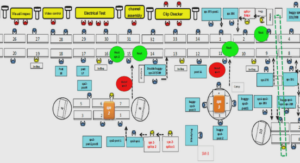General description of Bell 427
The Bell 427 is designed as a multiple purpose light helicopter. It is ideally suited for a wide variety of applications including executive and commuter transport, and cargo missions. The Bell 427 has a normal gross weight of 6350 lb and a maximum cruising speed ofup to 135 knots.
The pilot control inputs are augmented by hydraulic servo actuators. Movement of the cyclic stick is transmitted through the servo actuators to the swash plate, which actuates the rotating controls to the main rotor. A mechanical linkage through the collective servo actuator to the swash plate collective lever transmits movement of the collective control stick. The pedals provide the ability to control the tail rotor thrust in order to compensate for engine torque and to control the directional heading of the helicopter. The hydraulic servo actuator reduces the force required to move the pedals.
Prior to being transmitted to the rotor system, all cyclic and collective movements are transmitted through the mixing bell crank, which is located at the bottom of the control column. The mixing bell crank coordinates control movement so that when blade pitch is changed by moving the collective stick, the cyclic servo actuators and linkage also move in order to keep the swash plate in its relative plane.
The Bell 427 main rotor system uses a soft-in-plane flex bearn type hub with composite main rotor blades. It consists of a single composite yoke, elastomeric dampers and leadlag/pitch change bearings, metallic pitch homs, grips, and mast and blade attachment components.
The four individually replaceable mam rotor blades are constructed of composite materials. Each blade assembly consists of a fiberglass spar, Nomex honeycomb core, fiberglass skins and trailing edge strips, and a leading-edge stainless steel abrasion strip. The design RPM is 395 rot/min with a tip speed of 765 ft/sec (233 mis). Airfoil sections of the blade vary along the span.
The tail rotor is a two bladed teetering pusher type with composite blades, a metallic yoke, and elastomeric flapping bearing. The two tail rotor blades are constructed with fiberglass fabric skins, a unidirectional fiberglass/epoxy spar, and a nomex honeycomb core for corrosion avoidance. The design RPM is 2375 rot/min with a tip speed of 705 ft/sec (215 rn/sec).
The Bell 427 helicopter is powered by two Pratt & Whitney PW207D turbo shaft engines. The engine fuel control system is a single channel Full Authority Digital Electronic Control (F ADEC) with hydro mechanical backup. Each Pratt & Whitney PW207D turbo shaft engine is rated at 710 shp (529 kW) for takeoff (5 minutes), and 625 shp ( 466 kW) for maximum continuous power.
Optimal input design
Accuracy and reliability of parameter estimations depend on the amount of information available in the aircraft response. A good testing design accounts for practical constraints considered during the flight tests, while minimizing the flight test time [ 4]. The overall goal is the design of an experiment producing data from which model parameters can be accurately estimated. In this way, the system modes are excited so that the sensitivities of the model outputs to the parameters are high and correlations between parameters are low.
The design of an optimal input for accurate model parameter estimation requires high excitation of the system, which is opposite to practical constraints considered in flighttesting. One such practical constraint is the requirement that the output amplitude (e.g., in angle of attack or sideslip angle) variations about the flight test trim condition are limited to ensure the validation of the presumed model structure. Input amplitudes should be constrained for the same reasons, and in addition, to avoid non-linearities such as mechanical stops and rate limiting when the model is linear.
The inputs should excite all the modes of the analyzed model and should minimally excite the un-modeled modes. The system modes are best excited by frequencies near the system natural frequencies. Input frequencies much higher than the system natural frequencies give negligible responses, or excitation of higher frequency un-modeled modes. Very low input frequencies may result in static data.
The first form of multi-step test input signal that is traditionally used for the identification of fixed-wing aircraft is the doublet input. This input excites the short period mode in the longitudinal motion and the Dutch roll in the lateral mode. For a helicopter, although doublet inputs are of limited value, they are capable of exciting the modes in each axis. The doublet inputs are used together with other types of inputs, as they are not ideal for the highly coupled helicopter model.
The advantages of the 2311 control input are:
a. sufficiently high frequency content, provided by the altemating input strokes, m order to improve control derivative estimation;
b. ability to excite all the natural aircraft modes;
c. short time duration, easy to execute and to repeat;
d. no excitation of the higher frequency rotor modes, which are not included in the 6
DoF model.
Small maneuvers are suited to locally linearized aerodynamic models. Large maneuvers exceed the range of validity of locally linearized models and thus necessitate the use of nonlinear aerodynamic models. By use of small and large maneuvers models, the lower and upper bounds of the acceptable maneuver amplitudes are calculated. For most aircraft, the range between the lower and upper bounds is large, thus the best maneuver amplitudes are those located near the middle oftheir acceptable maneuver range [6].
The frequency sweep test techniques are recently used in the field of rotorcraft system identification, by Tischler et al. [7]. The frequency bandwidth of interest depends on the test objectives. For helicopter flying qualities studies, the typical frequency range of interest is between 0,5 Hz and 2Hz. In cases where the test objectives include rotor modes identification, the maximum frequency range of interest may be as high as 6 Hz [8]. In the frequency sweep tests, the pilot pro duces a sinusoidal input about a reference trim condition, beginning at very low frequency and progressively increasing the inputs frequency. Thus, the frequency sweep test should contain at !east 3 s of static trim data at the beginning and the end of the record. The total record length should be three to four times the maximum period of interest, i.e. a 60-90 s record length [7].
INTRODUCTION |





